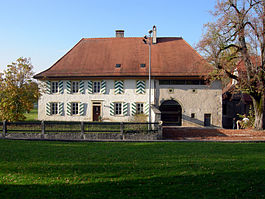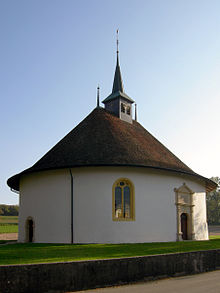- Chêne-Pâquier
-
Chêne-Pâquier Cure building in Le Pâquier village Country Switzerland 
Canton Vaud District Jura-Nord Vaudois 46°46′N 6°46′E / 46.767°N 6.767°ECoordinates: 46°46′N 6°46′E / 46.767°N 6.767°E Population 112 (Dec 2009)[1] - Density 53 /km2 (137 /sq mi) Area 2.11 km2 (0.81 sq mi) Elevation 662 m (2,172 ft) Postal code 1464 SFOS number 5908 Surrounded by Champtauroz, Chavannes-le-Chêne, Démoret, Molondin Website Chêne-Pâquier.ch
Profile, SFSO statisticsView map of Chêne-Pâquier Chêne-Pâquier is a municipality in the district of Jura-Nord Vaudois of the canton of Vaud in Switzerland.
Contents
History
Pâquier is first mentioned in 1462 as Pascua. In 1517 it was mentioned as Pasquier and in 1550, Chêne was mentioned as loz Chanoz.[2]
Geography
Chêne-Pâquier has an area, as of 2009[update], of 2.1 square kilometers (0.81 sq mi). Of this area, 1.46 km2 (0.56 sq mi) or 68.9% is used for agricultural purposes, while 0.51 km2 (0.20 sq mi) or 24.1% is forested. Of the rest of the land, 0.11 km2 (27 acres) or 5.2% is settled (buildings or roads).[3]
Of the built up area, housing and buildings made up 0.9% and transportation infrastructure made up 3.8%. Out of the forested land, 22.6% of the total land area is heavily forested and 1.4% is covered with orchards or small clusters of trees. Of the agricultural land, 60.8% is used for growing crops and 7.5% is pastures.[3]
The municipality was part of the Yverdon District until it was dissolved on 31 August 2006, and Chêne-Pâquier became part of the new district of Jura-Nord Vaudois.[4]
The municipality consists of the hamlets of Le Chêne and Le Pâquier.
Coat of arms
The blazon of the municipal coat of arms is Argent, a Base Vert, an Oak Tree proper leaved Vert and fructed of three Acorns Gules.[5]
Demographics
Chêne-Pâquier has a population (as of December 2009[update]) of 112.[1] As of 2008[update], 2.8% of the population are resident foreign nationals.[6] Over the last 10 years (1999–2009 ) the population has changed at a rate of 4.7%. It has changed at a rate of 3.7% due to migration and at a rate of 0.9% due to births and deaths.[7]
Most of the population (as of 2000[update]) speaks French (98 or 94.2%) as their first language, with German being second most common (4 or 3.8%) and Serbo-Croatian being third (1 or 1.0%).[8]
The age distribution, as of 2009[update], in Chêne-Pâquier is; 8 children or 7.1% of the population are between 0 and 9 years old and 16 teenagers or 14.3% are between 10 and 19. Of the adult population, 18 people or 16.1% of the population are between 20 and 29 years old. 11 people or 9.8% are between 30 and 39, 15 people or 13.4% are between 40 and 49, and 14 people or 12.5% are between 50 and 59. The senior population distribution is 11 people or 9.8% of the population are between 60 and 69 years old, 12 people or 10.7% are between 70 and 79, there are 6 people or 5.4% who are between 80 and 89, and there is 1 person who is 90 and older.[9]
As of 2000[update], there were 46 people who were single and never married in the municipality. There were 44 married individuals, 10 widows or widowers and 4 individuals who are divorced.[8]
As of 2000[update] the average number of residents per living room was 0.58 which is about equal to the cantonal average of 0.61 per room.[7] In this case, a room is defined as space of a housing unit of at least 4 m² (43 sq ft) as normal bedrooms, dining rooms, living rooms, kitchens and habitable cellars and attics.[10] About 74.4% of the total households were owner occupied, or in other words did not pay rent (though they may have a mortgage or a rent-to-own agreement).[11]
As of 2000[update], there were 41 private households in the municipality, and an average of 2.5 persons per household.[7] There were 14 households that consist of only one person and 6 households with five or more people. Out of a total of 42 households that answered this question, 33.3% were households made up of just one person and there was 1 adult who lived with their parents. Of the rest of the households, there are 9 married couples without children, 16 married couples with children There was one single parent with a child or children.[8]
In 2000[update] there were 25 single family homes (or 64.1% of the total) out of a total of 39 inhabited buildings. There were 3 multi-family buildings (7.7%), along with 10 multi-purpose buildings that were mostly used for housing (25.6%) and 1 other use buildings (commercial or industrial) that also had some housing (2.6%).[12]
In 2000[update], a total of 39 apartments (88.6% of the total) were permanently occupied, while 2 apartments (4.5%) were seasonally occupied and 3 apartments (6.8%) were empty.[12] As of 2009[update], the construction rate of new housing units was 0 new units per 1000 residents.[7] The vacancy rate for the municipality, in 2010[update], was 0%.[7]
The historical population is given in the following chart:[2][13]

Heritage sites of national significance
The Temple and Cure is listed as a Swiss heritage site of national significance. The entire area around Chêne-Pâquier is part of the Inventory of Swiss Heritage Sites.[14]
Politics
In the 2007 federal election the most popular party was the SVP which received 36.59% of the vote. The next three most popular parties were the FDP (25.24%), the SP (12.56%) and the Green Party (7.2%). In the federal election, a total of 47 votes were cast, and the voter turnout was 53.4%.[15]
Economy
As of 2010[update], Chêne-Pâquier had an unemployment rate of 2.5%. As of 2008[update], there were 10 people employed in the primary economic sector and about 4 businesses involved in this sector. 24 people were employed in the secondary sector and there were 2 businesses in this sector. No one was employed in the tertiary sector.[7] There were 43 residents of the municipality who were employed in some capacity, of which females made up 46.5% of the workforce.
In 2008[update] the total number of full-time equivalent jobs was 30. The number of jobs in the primary sector was 6, all of which were in agriculture. The number of jobs in the secondary sector was 24, all of which were in construction.[16]
In 2000[update], there were 5 workers who commuted into the municipality and 30 workers who commuted away. The municipality is a net exporter of workers, with about 6.0 workers leaving the municipality for every one entering.[17] Of the working population, 4.7% used public transportation to get to work, and 67.4% used a private car.[7]
Religion
From the 2000 census[update], 7 or 6.7% were Roman Catholic, while 93 or 89.4% belonged to the Swiss Reformed Church. Of the rest of the population, there were 2 members of an Orthodox church (or about 1.92% of the population), and there was 1 individual who belongs to another Christian church. 1 (or about 0.96% of the population) belonged to no church, are agnostic or atheist.[8]
Education
In Chêne-Pâquier about 41 or (39.4%) of the population have completed non-mandatory upper secondary education, and 8 or (7.7%) have completed additional higher education (either University or a Fachhochschule). Of the 8 who completed tertiary schooling, 50.0% were Swiss men, 50.0% were Swiss women.[8]
As of 2000[update], there were 10 students in Chêne-Pâquier who came from another municipality, while 20 residents attended schools outside the municipality.[17]
References
- ^ a b Swiss Federal Statistical Office, MS Excel document – Bilanz der ständigen Wohnbevölkerung nach Kantonen, Bezirken und Gemeinden (German) accessed 25 August 2010
- ^ a b Chêne-Pâquier in German, French and Italian in the online Historical Dictionary of Switzerland.
- ^ a b Swiss Federal Statistical Office-Land Use Statistics 2009 data (German) accessed 25 March 2010
- ^ Nomenklaturen – Amtliches Gemeindeverzeichnis der Schweiz (German) accessed 4 April 2011
- ^ Flags of the World.com accessed 19-August-2011
- ^ Swiss Federal Statistical Office - Superweb database - Gemeinde Statistics 1981-2008 (German) accessed 19 June 2010
- ^ a b c d e f g Swiss Federal Statistical Office accessed 19-August-2011
- ^ a b c d e STAT-TAB Datenwürfel für Thema 40.3 - 2000 (German) accessed 2 February 2011
- ^ Canton of Vaud Statistical Office (French) accessed 29 April 2011
- ^ Eurostat. "Housing (SA1)" (pdf). Urban Audit Glossary. 2007. p. 18. http://www.bfs.admin.ch/bfs/portal/en/index/international/22/lexi.Document.116365.pdf. Retrieved 12 February 2010.
- ^ Urban Audit Glossary pg 17
- ^ a b Swiss Federal Statistical Office STAT-TAB - Datenwürfel für Thema 09.2 - Gebäude und Wohnungen (German) accessed 28 January 2011
- ^ Swiss Federal Statistical Office STAT-TAB Bevölkerungsentwicklung nach Region, 1850-2000 (German) accessed 29 January 2011
- ^ "Kantonsliste A-Objekte" (in German). KGS Inventar. Federal Office of Civil Protection. 2009. http://www.bevoelkerungsschutz.admin.ch/internet/bs/de/home/themen/kgs/kgs_inventar/a-objekte.html. Retrieved 25 April 2011.
- ^ Swiss Federal Statistical Office, Nationalratswahlen 2007: Stärke der Parteien und Wahlbeteiligung, nach Gemeinden/Bezirk/Canton (German) accessed 28 May 2010
- ^ Swiss Federal Statistical Office STAT-TAB Betriebszählung: Arbeitsstätten nach Gemeinde und NOGA 2008 (Abschnitte), Sektoren 1-3 (German) accessed 28 January 2011
- ^ a b Swiss Federal Statistical Office - Statweb (German) accessed 24 June 2010
Categories:- Municipalities of the canton of Vaud
- Municipalities of Switzerland
- Cultural property of national significance in the canton of Vaud
Wikimedia Foundation. 2010.



